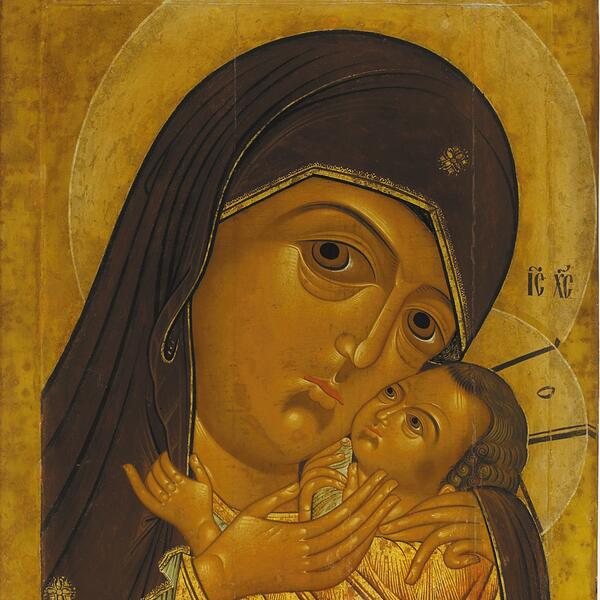Our Lady of Korsun can be traced back to one of the oldest images of the Virgin Mary which is believed to have been painted by Saint Luke the apostle. As it appears from the name of the icon, it originated in the city of Korsun, nowadays known as Chersonesus. In the 16th and 17th centuries, all highly revered sacred objects which came from this region were referred to using this name.
There are two versions of how this icon came to Russia. According to one legend, it was brought by Prince Vladimir who was baptized in Korsun. The icon was placed in the Saint Sophia Cathedral in Novgorod and later transferred to the Dormition Cathedral in the Moscow Kremlin. Another story says that the icon was painted in the 12th century and presented to Princess Euphrosyne of Polotsk. Alternatively, both of these stories may be true, describing various copies of the same icon.
The image is also known as the Ephesus icon. According to the Bible, Virgin Mary, accompanied by John the Apostle, sought refuge in the city of Ephesus after the death of Jesus Christ.
Originally, the word Korsun was only applied to icons of the Hodegetria style, but later chest-length Eleusa icons, or the Virgin of Tenderness, were also classified as such. This is one of the most common and lyrical images of the Mother of God, imbued with the love and mutual trust of the Mother and the Son. Art experts highlight its symbolic meaning, with the Mother of God representing humanity in general or the human soul in close contact with God, while the image of the Child Jesus is interpreted as a symbol of the unconditional love of God for humans.
Usually, such icons were small and placed at home. The size of the item on display indicates that it was designed for the church iconostasis and placed in the local tier. This is a rather rare use of this icon.
The 17th century is considered the golden age of Yaroslavl art. During that period, the contribution of merchants and art connoisseurs helped to build many stone churches in Yaroslavl, and icon painters were able to show their skills. The veneration of this icon is associated with the Yaroslavl Church of Saint Demetrius of Thessaloniki.
There are two versions of how this icon came to Russia. According to one legend, it was brought by Prince Vladimir who was baptized in Korsun. The icon was placed in the Saint Sophia Cathedral in Novgorod and later transferred to the Dormition Cathedral in the Moscow Kremlin. Another story says that the icon was painted in the 12th century and presented to Princess Euphrosyne of Polotsk. Alternatively, both of these stories may be true, describing various copies of the same icon.
The image is also known as the Ephesus icon. According to the Bible, Virgin Mary, accompanied by John the Apostle, sought refuge in the city of Ephesus after the death of Jesus Christ.
Originally, the word Korsun was only applied to icons of the Hodegetria style, but later chest-length Eleusa icons, or the Virgin of Tenderness, were also classified as such. This is one of the most common and lyrical images of the Mother of God, imbued with the love and mutual trust of the Mother and the Son. Art experts highlight its symbolic meaning, with the Mother of God representing humanity in general or the human soul in close contact with God, while the image of the Child Jesus is interpreted as a symbol of the unconditional love of God for humans.
Usually, such icons were small and placed at home. The size of the item on display indicates that it was designed for the church iconostasis and placed in the local tier. This is a rather rare use of this icon.
The 17th century is considered the golden age of Yaroslavl art. During that period, the contribution of merchants and art connoisseurs helped to build many stone churches in Yaroslavl, and icon painters were able to show their skills. The veneration of this icon is associated with the Yaroslavl Church of Saint Demetrius of Thessaloniki.



